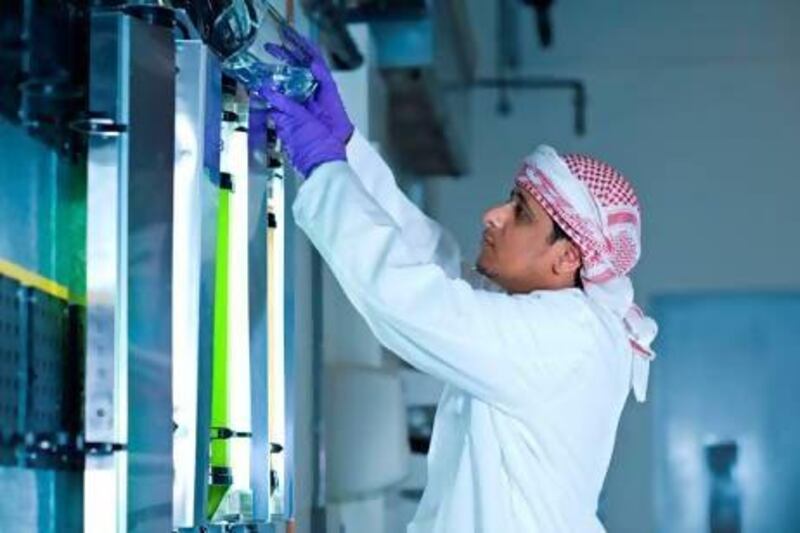ABU DHABI // Like 21st century oil prospectors, researchers from Abu Dhabi have been roaming the open desert with geospatial mapping software, scouting for treasure in the sands.
But instead of seeking black crude bubbling beneath the soil, they are looking for blooms of green – the colour of a particularly hardy strain of algae, AAH001. It is native to Abu Dhabi, and the scientists hope it could eventually usher in another energy boom for the UAE.
Hector Hernandez, the assistant professor at the Masdar Institute who is leading the research, first located AAH001 two years ago in the desert near Al Wathba. He believes it could solve a big obstacle in the effort to use single-celled, photosyntheti organisms to make a renewable, alternative fuel.
"Most of the algae used for biofuels we've heard about to date use fresh water, and there's huge evaporation," said Dr Hernandez. "In the last two years, people have realised that's not sustainable.
"They've been looking for algae that lives at high salinities. We found it in Abu Dhabi, and we realised we had something special. This thing is a rock star."
Unlike most algal strains, AAH001 can thrive without fresh water. It survives remarkably well in a wide range of temperatures and has a long harvesting season. "I can grow this from 20°C all the way up to 40°C without worrying about evaporation or the salinity," Dr Hernandez said. "It seems to live very well, not just survive, in all these different conditions."
While other biofuels researchers have been looking to the oceans to find a such a game-changing algal strain, Dr Hernandez said he was pleasantly surprised in February 2011 to discover AAH001 in the desert, growing near ultra-high salinity watering holes in the sabkha salt flats. Ponds in the area have salinities that are up to six times higher than the ocean. When he returned the following September to collect samples, the algae were still thriving.
In a basement lab at the Masdar Institute, Dr Hernandez and his team have been able to grow the algae at more than 300 parts per thousand salt – roughly nine times the regular salinity of the ocean.
The samples live in 2.5-litre water tanks called bioreactors, which have varying salinities to test the algae's ability to endure extreme conditions. They are cultivated in various solutions of micronutrients to find the optimal mix to help them grow rapidly.
Biofuels derived from algae oils have been trumpeted as one answer to our dependence on fossil fuels, but critics say the large amounts of energy and water needed to cultivate the algae calls into question their sustainability. That is why the AAH001 holds such promise. It is considerably lower maintenance, and does not require the same specialised feed, strict temperatures or salinity controls as other algae.
These unique characteristics, and the ability to grow the strain inland, make it an ideal candidate for producing biofuels that could then be exported. "It seems to be the only strain to date that has all the qualities we're looking for," said Dr Hernandez.
With so much uninhabitable desert available in Abu Dhabi, processing plants could be built inland and around large salt flats rather than by the sea, where they would harm ecologically sensitive marine life. The Abu Dhabi strain can even subsist on brackish water or wastewater from treatment plants.
The commercial possibilities were discussed in February at the inaugural Algae World MENA 2013 Conference, Seminar and Summit in Dubai, which was attended by Dr Hernandez and international algae industry specialists.
"We've been approached by very large corporations internationally who want to take this to the next step as soon as possible," he said. "There was talk of growing the algae in spaces of up to 200 hectares. If you want to build something that big, come on down."
Some of the oils made by the algae are very similar to fossil fuels in mineral deposits. Although the organisms are living cells, they contain energy-rich hydrocarbons that can be broken down into oily lipids, which can in turn be extracted and converted into transportation fuel, Dr Hernandez explained.
Those bio-oils can also be turned into higher-value products, for use in aviation, for example.
"We can take those lipids, and do a bit more work to them, and then we can make some higher-value energy molecules that could lead to something else," he said. "Something like the holy grail, which is jet fuel."
Although the possibilities are tantalising, producing algae-derived fuels on a commercial scale is still far more expensive than traditional fossil fuels. Biofuels produced from algae would cost US$2.11 (Dh7.75) per litre using current technology, whereas it would cost half that for a litre of soybean oil produced in large volumes, according to the United States Department of Energy.
One way of reducing the cost would be to scale up the production of valuable by-products from the algae. "People want the cell walls, but are throwing the rest of the algae away," said Dr Hernandez. "It's like taking an orange and squeezing it, getting the juice out, but missing the pulp, the zest, the peel, the other parts. We're trying to get at the other parts of the algae, and these other parts are more valuable right now in the market."
Those by-products include nutritional supplements, antibiotics, pharmaceutical products and even cosmetics. Some labs have been able to use genome sequencing to identify molecules that the algae can make for medicine, including anti-cancer agents, antimicrobials and antiviral agents.
For now, Dr Hernandez plans to experiment with taking the AAH001 strain out of the bioreactors and farming it outside. By the end of this year, he hopes that the Masdar Institute will have an outdoor pond for exactly that purpose.
"We have the land, we have the space available, and we're just looking for somebody who has the expertise and technology to scale up from pond size," he said.
newsdesk@thenational.ae






